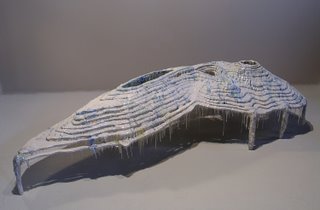Columbia Glacier





Columbia Glacier, 2006, plastic over plywood, 29"x95"x39".
Columbia Glacier has no armature. It was constructed by temporarily arranging concentric topographic rings into a three-dimensional shape, and then pouring fast-curing plastic through the skeletal plywood form. The weight of the plastic and the unstructural quaity of the plywood caused quite a bit of initial deformation. Eventually, enough plastic accreted on the plywood to cement the form together and create a structurally sound sculpture.
This piece is based on a real glacier in Alaska that is, of course, receeding.

0 Comments:
Post a Comment
<< Home